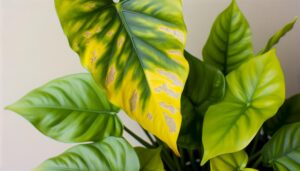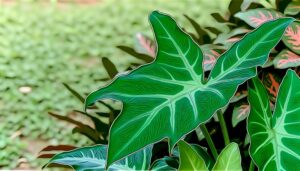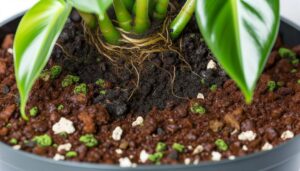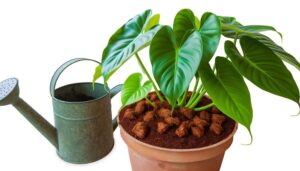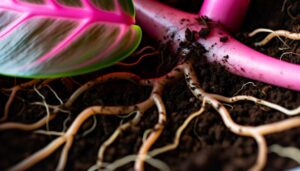Can a Philodendron Birkin Get Sunburned? Yes!
Yes, a Philodendron Birkin can get sunburned if exposed to direct sunlight for extended periods. Signs of sunburn include discolored leaves, yellowing, browning, chlorosis, and localized necrosis.
To prevent sunburn, place the plant in bright, indirect light and use sheer curtains to diffuse intense rays. Ideal conditions involve positioning near east or north-facing windows.
Quick intervention, such as relocating the plant to shaded areas and trimming damaged leaves, is crucial for recovery. Consistent lighting conditions are necessary for maintaining plant health and minimizing photodamage.
Understanding these essential care practices ensures robust growth and longevity.
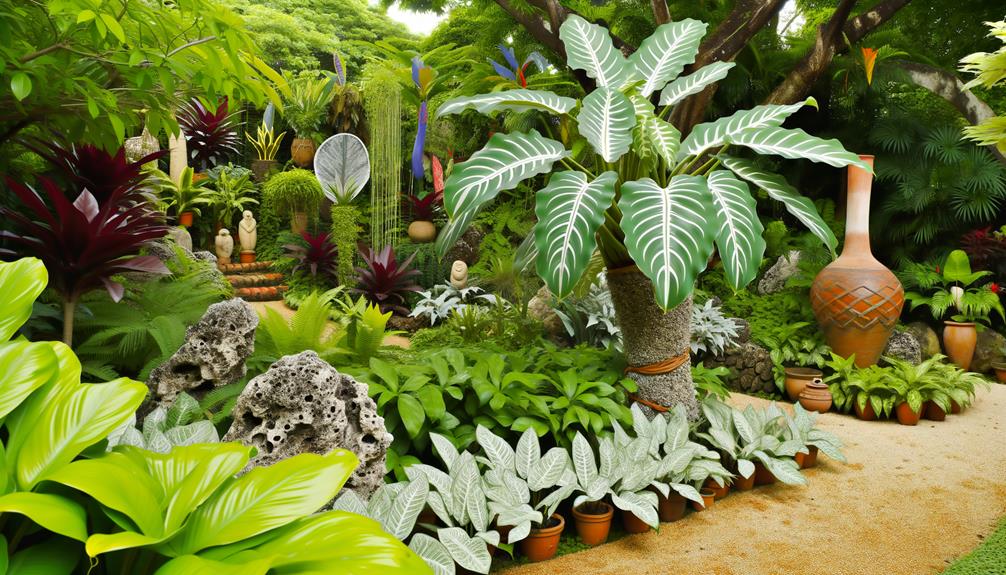
Key Takeaways
- Yes, direct sunlight can cause sunburn on Philodendron Birkin leaves.
- Symptoms of sunburn include discolored, yellowing, or browning leaves.
- Shielding from direct sunlight with sheer curtains or shade is essential.
- Positioning near east or north-facing windows offers ideal indirect light.
- Prompt intervention and relocation to shaded areas aid in recovery.
Understanding Philodendron Birkin
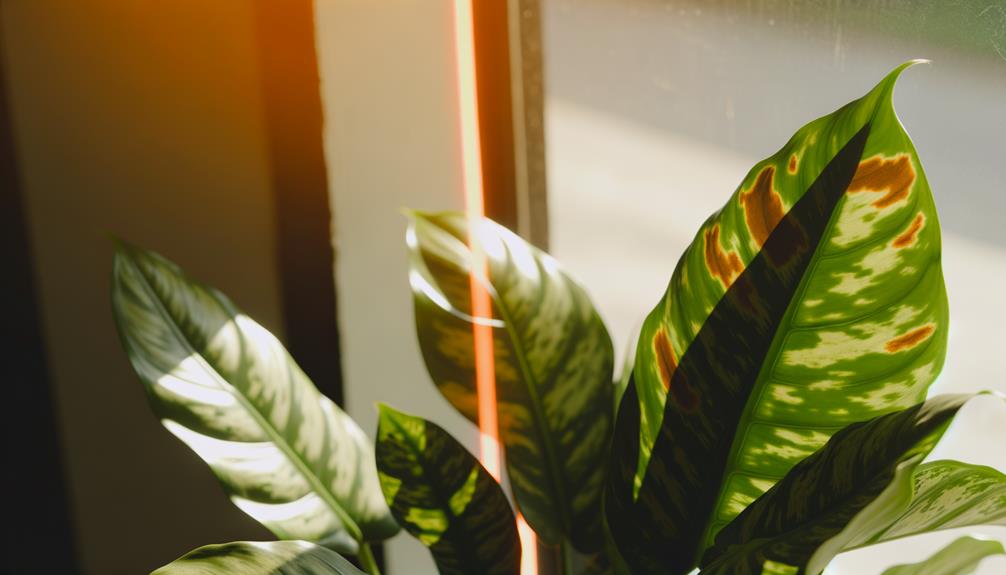
The Philodendron Birkin, a cultivar known for its distinctive variegated foliage, demands thoughtful consideration to understand its growth requirements and environmental preferences.
Native to the tropical rainforests of South America, this plant thrives in conditions mimicking its natural habitat. Best growth is achieved in well-draining, nutrient-rich soil that maintains consistent moisture without becoming waterlogged.
Temperature stability between 65-80°F (18-27°C) is ideal, as the Philodendron Birkin is sensitive to cold drafts and sudden temperature fluctuations. Humidity levels should be moderate to high, replicating its tropical origins.
Additionally, the plant benefits from regular fertilization during the growing season, using a balanced, water-soluble fertilizer. Understanding these parameters is essential for maintaining the health and aesthetic appeal of the Philodendron Birkin.
Sunlight Needs
Perfect sunlight exposure is crucial for the Philodendron Birkin, needing bright, indirect light to sustain its vibrant variegation and overall health. This tropical plant thrives in environments that mimic the dappled sunlight conditions of its native habitats.
Direct sunlight can be harmful, causing leaf damage and potential sunburn. Research suggests that placing the Philodendron Birkin near an east or north-facing window provides prime light without the risk of direct sun exposure. Additionally, artificial grow lights can be advantageous during low-light periods, ensuring consistent light levels.
Monitoring light intensity with a lux meter can further aid in maintaining suitable conditions, as recommended levels fall between 10,000 to 20,000 lux. Proper light management is crucial to the plant’s well-being.
Signs of Sunburn
Sunburn in Philodendron Birkin is primarily indicated by discolored leaves, often turning yellow or brown. Leaf scorching, characterized by brown, crispy edges or patches, is another clear sign.
These symptoms result from excessive exposure to direct sunlight, which disrupts the plant’s cellular structure.
Discolored Leaves
Frequently, discolored leaves on a Philodendron Birkin can serve as a primary indicator of sunburn. This discoloration typically manifests as yellowing or browning of the leaf tissues.
Photosynthetic pigments degrade under excessive sunlight exposure, leading to chlorosis, characterized by the yellowing of the leaf surface. Additionally, localized necrosis may occur, presenting as brown patches, particularly on the leaf margins and tips.
This damage impairs the plant’s ability to photosynthesize efficiently, compromising overall vigor. Recognizing these signs early is crucial to mitigate further damage.
Adjusting the plant’s location to avoid direct sunlight or using sheer curtains can provide sufficient light while preventing harmful UV exposure. Prompt intervention can restore the Philodendron Birkin to its best health.
Leaf Scorching
Beyond general discoloration, leaf scorching is a more severe manifestation of sunburn in Philodendron Birkin, characterized by extensive browning and desiccation of leaf tissues. This condition results from prolonged exposure to direct sunlight, which overwhelms the plant’s ability to manage light intensity, leading to cellular damage. Recognizing the signs early is essential for preventive measures.
| Symptom | Description |
|---|---|
| Browning | Large areas of the leaf turn brown |
| Desiccation | Leaf tissues become dry and brittle |
| Leaf Curl | Edges of leaves curl inwards |
| Vein Visibility | More pronounced leaf veins |
Effective management involves relocating the plant to an area with diffused light, ensuring it receives adequate but not excessive illumination.
Optimal Light Conditions
Providing the best light conditions for the Philodendron Birkin is essential for its health and growth. This plant thrives in bright, indirect light, which mimics the dappled sunlight of its native tropical understory. Light intensity should be moderate, avoiding both full sunlight and deep shade.
Research indicates that exposure to direct sunlight can lead to photodamage, showing as leaf scorching or discoloration. Conversely, insufficient light can result in etiolation, characterized by elongated stems and pale leaves.
The ideal placement is near an east or north-facing window, where the plant can receive sufficient, filtered light. Using sheer curtains can help reduce intense rays. Maintaining these vital light conditions ensures strong foliage and overall health of the Philodendron Birkin.
Preventing Sunburn
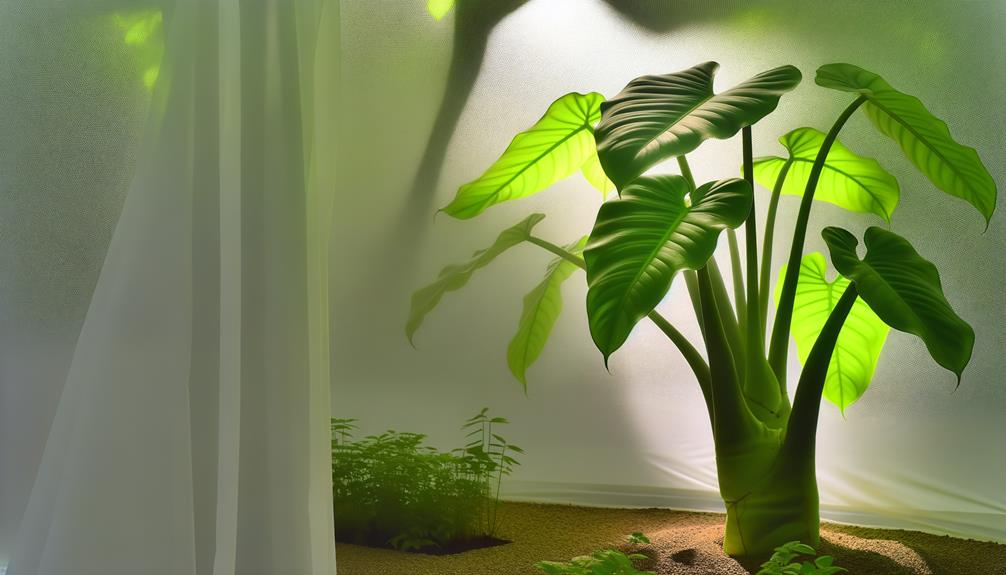
To prevent sunburn in Philodendron Birkin, it is vital to shield the plant from direct sunlight by using filters such as sheer curtains or placing it in a location with only indirect light. Research indicates that Philodendron Birkin thrives in environments that mimic its native tropical understory conditions, where light is diffused and moderate.
Employing ultraviolet light filters on windows can further mitigate the risk of sunburn. Additionally, rotating the plant regularly ensures even light exposure, reducing stress on specific leaf sections. Monitoring leaf coloration and texture provides early indicators of excessive light exposure, allowing timely adjustments.
Implementing these strategies not only prevents sunburn but also promotes optimal growth and pigmentation in Philodendron Birkin, maintaining its aesthetic appeal and health.
Indoor Vs. Outdoor Placement
Determining whether to place a Philodendron Birkin indoors or outdoors hinges on understanding its specific light, temperature, and humidity requirements.
Philodendron Birkin thrives in indirect light, making it more suited for indoor environments where light intensity can be controlled. Direct sunlight can cause leaf burn, while insufficient light may stunt growth.
Ideal temperature ranges are between 65-75°F, conditions easily maintained indoors. Additionally, this species prefers high humidity levels, ideally 60-70%, which can be challenging to achieve consistently in outdoor settings.
Outdoor placement exposes the plant to fluctuating temperatures and humidity, potentially inducing stress. Thus, maintaining a controlled indoor environment aligns better with the Philodendron Birkin’s needs, ensuring healthy growth and minimizing the risk of sunburn.
Adjusting Light Exposure
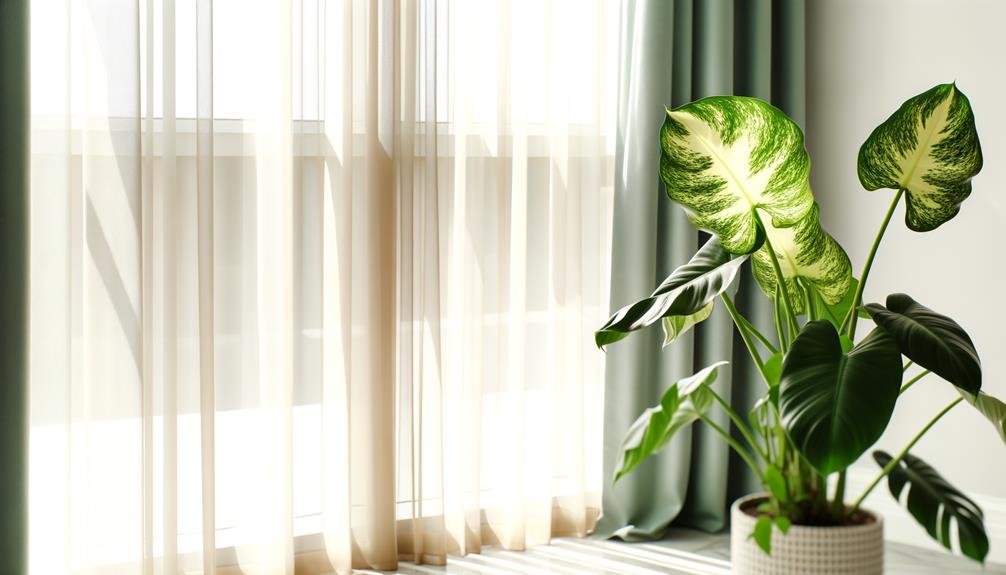
To guarantee the Philodendron Birkin thrives, it is essential to provide ideal light conditions, which typically involve bright, indirect sunlight.
Direct exposure to sunlight can cause the foliage to become sunburned, leading to discoloration and damage.
As a result, positioning the plant near a window with filtered light or in a well-lit room is suggested to maintain its health and aesthetic appeal.
Optimal Light Conditions
Ensuring perfect light conditions for a Philodendron Birkin involves balancing exposure to indirect sunlight to prevent sunburn while promoting healthy growth. This tropical plant thrives best under bright, indirect light, which simulates the filtered sunlight of its native rainforest understory.
Research indicates that insufficient light can lead to leggy growth and diminished variegation, while excessive light exposure can cause leaf scorching. A light meter can be instrumental in maintaining ideal light intensity, ideally between 200-400 foot candles. Positioning the plant near an east or north-facing window can provide the right balance.
For artificial lighting, full-spectrum LED grow lights set on a 12-14 hour cycle can effectively mimic natural conditions, ensuring robust photosynthesis and vibrant foliage.
Avoiding Direct Sunlight
Shielding the Philodendron Birkin from direct sunlight is crucial to prevent leaf damage and maintain its vibrant variegation. Exposure to intense sunlight can lead to photodamage, showing as brown, scorched patches on foliage.
To lessen this risk, position the plant in an area receiving bright, indirect light. East-facing windows offer ideal exposure, providing gentle morning sunlight without the harsh intensity of midday rays. Alternatively, using sheer curtains can scatter direct sunlight effectively.
For artificial lighting, full-spectrum grow lights, positioned at an appropriate distance, mimic natural light conditions without excessive exposure. Regularly monitor the plant’s foliage for any signs of light stress, adjusting its placement as needed to ensure a healthy, visually pleasing appearance.
Recovery From Sunburn
Recovery from sunburn in a Philodendron Birkin demands immediate and appropriate care to mitigate damage and promote healing.
First, relocate the plant to a shaded area to prevent further exposure.
Trim any severely damaged leaves to conserve the plant’s energy for new growth.
Ensure peak hydration by maintaining consistent, but not excessive, watering.
Consider using a balanced, diluted fertilizer to support recovery.
Additionally, monitoring humidity levels is essential; a humid environment can enhance the plant’s recuperative processes.
Avoid overwatering, as this can lead to root rot, exacerbating stress.
Finally, allow time for gradual adaptation to indirect light, which can prevent recurrence.
Seasonal Light Changes
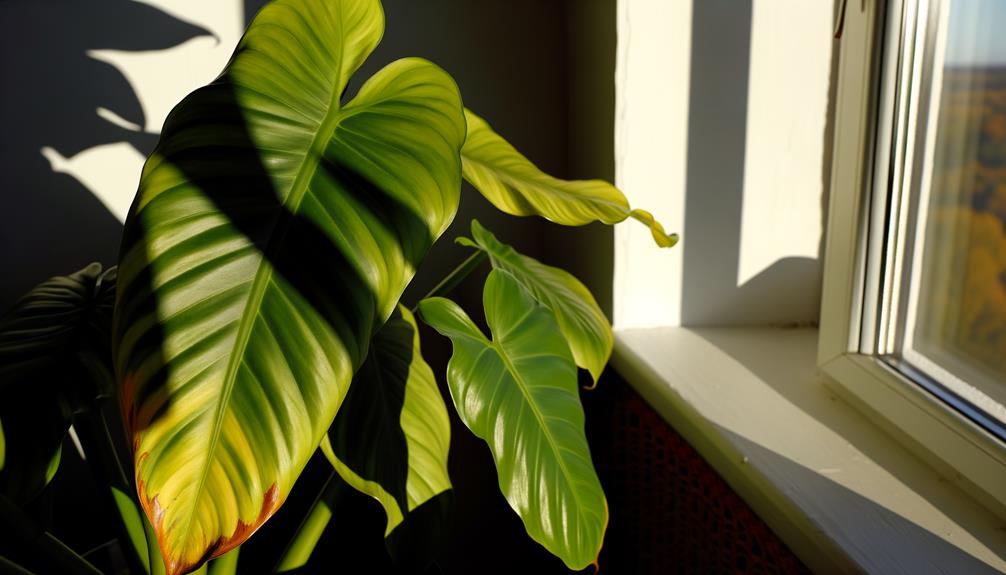
Seasonal light changes greatly impact the growth and health of a Philodendron Birkin, necessitating adjustments in care practices to accommodate varying light intensities. During winter, shorter daylight hours and lower light intensity can impede photosynthesis, leading to slower growth.
Conversely, the increased light during summer can elevate the risk of sunburn if the plant is exposed to direct sunlight. To mitigate these seasonal fluctuations, positioning the Philodendron Birkin in a location with consistent, indirect light is necessary. Using sheer curtains can diffuse harsh sunlight, reducing the likelihood of sunburn.
Additionally, supplemental lighting during darker months can help maintain best growth conditions. Monitoring and adjusting light exposure according to seasonal variations is important for ensuring the plant’s overall strength.
Additional Care Tips
To promote peak health and growth, it is important to implement additional care practices tailored to the specific needs of the Philodendron Birkin. Best soil composition, including a mix of peat, perlite, and orchid bark, ensures proper aeration and drainage.
Regular watering should maintain soil moisture without causing waterlogging, typically every 1-2 weeks depending on environmental conditions. Humidity levels between 40-60% are ideal; using a humidifier or pebble tray can help achieve this.
Fertilize monthly during the growing season with a balanced, water-soluble fertilizer at half strength. Pruning dead or damaged leaves not only enhances aesthetics but also promotes vigorous growth. Regular monitoring for pests, such as spider mites and aphids, is essential for maintaining plant health.
Conclusion
To sum up, Philodendron Birkin requires careful management of light exposure to prevent sunburn, characterized by leaf discoloration and damage.
While some may argue that indoor plants are less prone to sunburn, evidence indicates that improper light conditions, even indoors, can adversely affect plant health.
Best light conditions, preventive measures, and proper care are crucial for maintaining the health of Philodendron Birkin, ensuring it thrives in both natural and artificial environments.


